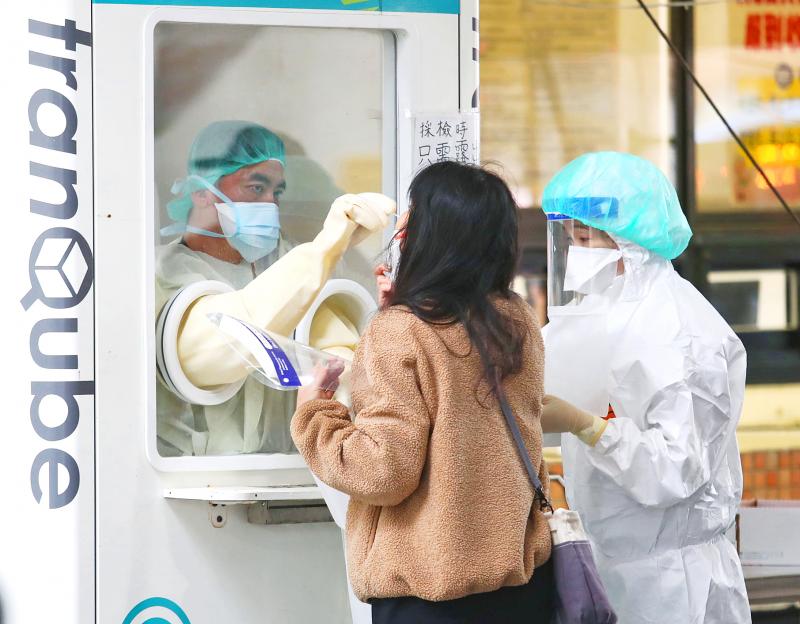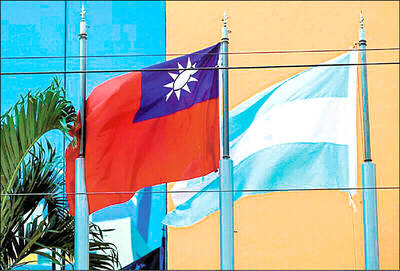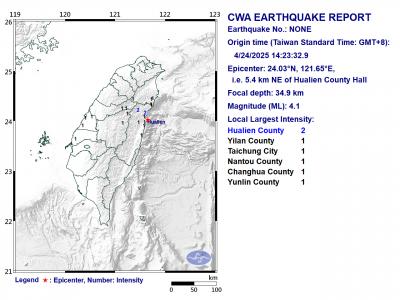People with no symptoms must have tested positive for COVID-19 using a rapid test to be eligible for a polymerase chain reaction (PCR) test, the Central Epidemic Command Center (CECC) announced yesterday.
Many emergency rooms in Taipei and New Taipei City have been crowded with people waiting to receive a PCR test in the past few days.
Minister of Health and Welfare Chen Shih-chung (陳時中), who heads the center, yesterday said five measures would be implemented to preserve the critical medical capacity at emergency rooms.

Photo: CNA
The center has asked local governments to set up additional community testing stations based on the COVID-19 situation in the area, and encouraged local clinics to assist in performing testing services to expand testing capacity, he said.
Hospitals with emergency rooms have been asked to open special outpatient clinics to assess whether people who have a fever or have tested positive for COVID-19 using a rapid test and have mild or no symptoms need a PCR test or treatment, he said.
“People who are asymptomatic must have tested positive with a rapid test at home before they receive a PCR test,” Chen said.
Hospitals have also been asked to launch a mechanism to reduce non-urgent services, and to redeploy staff to support those who are conducting COVID-19 testing and reporting, and managing hospital bed availability, he said.
The vacancy rate of hospital beds in designated COVID-19 hospital rooms and negative pressure isolation wards is 54.2 percent (4,179 beds), while it is 32.8 percent (2,354 beds) at centralized quarantine facilities and 33.6 percent (1,235 beds) at enhanced disease prevention hotels, he said.
Meanwhile, the CECC yesterday reported 17,801 new local COVID-19 cases and 57 imported cases.
Three deaths, 14 moderate cases and seven severe cases were confirmed.
Centers for Disease Control Deputy Director-General Philip Lo (羅一鈞), deputy head of the CECC’s medical response division, said a woman in her 90s, a woman in her 80s and a man in his 70s died.
They all had underlying health conditions and had received zero to two COVID-19 vaccine doses, he said.
Of the seven severe cases, one is an infant under the age of one, who has a neurological disorder.
She was taken to a clinic with a fever, but as she was not in contact with a confirmed case, she was not tested for COVID-19, Lo said.
However, the infant later had difficulty breathing and a hoarse voice, so she was taken to an emergency room for treatment, where she tested positive for COVID-19, Lo said, adding that she is on a ventilator and being treated in an intensive care unit.
Another severe case is a woman in her 20s, who has no underlying health conditions and had received a booster vaccine, Lo said, adding that she tested positive after seeking treatment for a fever and diarrhea last week.
The woman continued to experience abdominal pain, vomiting and diarrhea during home quarantine, so she sought treatment again on Friday, Lo said.
She was found to have low blood pressure, abnormal kidney function and had difficulty breathing, so she was put on a ventilator and admitted to an intensive care unit, he said.
The guidelines for distinguishing high-risk patients say that infants under the age of one, who have contracted COVID-19, should be hospitalized if they have a fever, as their immune systems have not yet fully matured and their condition could worsen very quickly, Lo said.

PRAISE: Japanese visitor Takashi Kubota said the Taiwanese temple architecture images showcased in the AI Art Gallery were the most impressive displays he saw Taiwan does not have an official pavilion at the World Expo in Osaka, Japan, because of its diplomatic predicament, but the government-backed Tech World pavilion is drawing interest with its unique recreations of works by Taiwanese artists. The pavilion features an artificial intelligence (AI)-based art gallery showcasing works of famous Taiwanese artists from the Japanese colonial period using innovative technologies. Among its main simulated displays are Eastern gouache paintings by Chen Chin (陳進), Lin Yu-shan (林玉山) and Kuo Hsueh-hu (郭雪湖), who were the three young Taiwanese painters selected for the East Asian Painting exhibition in 1927. Gouache is a water-based

Taiwan would welcome the return of Honduras as a diplomatic ally if its next president decides to make such a move, Minister of Foreign Affairs Lin Chia-lung (林佳龍) said yesterday. “Of course, we would welcome Honduras if they want to restore diplomatic ties with Taiwan after their elections,” Lin said at a meeting of the legislature’s Foreign Affairs and National Defense Committee, when asked to comment on statements made by two of the three Honduran presidential candidates during the presidential campaign in the Central American country. Taiwan is paying close attention to the region as a whole in the wake of a

A magnitude 4.1 earthquake struck eastern Taiwan's Hualien County at 2:23pm today, according to the Central Weather Administration (CWA). The epicenter of the temblor was 5.4 kilometers northeast of Hualien County Hall, at a depth of 34.9 km, according to the CWA. The earthquake's intensity, which gauges the actual effect of a temblor, was the highest in Hualien County, where it measured 2 on Taiwan's 7-tier intensity scale. The quake also measured an intensity of 1 in Yilan county, Taichung, Nantou County, Changhua County and Yunlin County, the CWA said. There were no immediate reports of damage or injuries.

OFF-TARGET: More than 30,000 participants were expected to take part in the Games next month, but only 6,550 foreign and 19,400 Taiwanese athletes have registered Taipei city councilors yesterday blasted the organizers of next month’s World Masters Games over sudden timetable and venue changes, which they said have caused thousands of participants to back out of the international sporting event, among other organizational issues. They also cited visa delays and political interference by China as reasons many foreign athletes are requesting refunds for the event, to be held from May 17 to 30. Jointly organized by the Taipei and New Taipei City governments, the games have been rocked by numerous controversies since preparations began in 2020. Taipei City Councilor Lin Yen-feng (林延鳳) said yesterday that new measures by